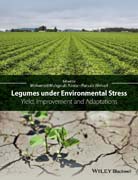
Legumes under Environmental Stress: Yield, Improvement and Adaptations
Ahmad, Parvaiz
Leguminous crops have been found to contribute almost 27% of theworld's primary crop production. However, due toenvironmental fluctuations, legumes are often exposed to differentenvironmental stresses, leading to problems with growth anddevelopment, and ultimately, decreased yield. This timely review explains the transcriptomics, proteomics,genomics, metabolomics, transgenomics, functional genomics andphenomics of a wide range of different leguminous crops underbiotic and abiotic stresses, and their genetic and molecularresponses. Amongst others the text describes the effect of nutrientdeficiency, pesticides, salt, and temperature stress onlegumes. Importantly, the book explores the physiobiochemical, molecular andomic approaches that are used to overcome biotic and abioticconstraints in legumes. It looks at the exogenous application ofphytoprotectants; the role of nutrients in the alleviation ofabiotic stress; and the microbial strategy for the improvement oflegume production under hostile environments. Key features: demonstrates how to mitigate the negative effect of stress onleguminous crops, and how to improve the yield under stress the most up-to-date research in the field written by an international team of active researchers andpractitioners across academia, industry and non-profit organisations This volume is a valuable and much-needed resource for scientists,professionals and researchers working in plant science, breeding,food security, crop improvement and agriculture worldwide. Inuniversities it will educate postgraduate and graduate students inplant science and agriculture; it will also benefit those inscientific institutions and in biotech and agribusiness companies,who deal with agronomy and environment. INDICE: List of contributorsPrefaceAbout the EditorsChapter 11. Introduction2. Legumes under Abiotic stress3. Cool Season Food Legumes Breeding4. Cool Season Food Legumes Breeding Under Abiotic Stress5. Warm Season Food Legumes Breeding6. Warm Season Food Legumes Breeding Under Abiotic Stress7. Biotechnology Approaches8. Conclusions and Future ProspectsReferencesChapter 21. Introduction2. Effect of salt stress on plants3. Responses of plants to salt stress4. Lessons from the studies of leguminous crops5. Omic approaches for understanding salt stress responses in legumes6. Conclusion and future prospectusReferencesChapter 31. Introduction2. Environmental stresses and crop growth3. Effects of nutrient deficiency4. Methods to control nutrient deficiency5. Micronutrient deficiency in plants6. Role of Macronutrient in growth of legumes7. Storage proteins in legumes and effect of nutritional deficiency8. Protective mechanisms triggered in legumes under stress9. ConclusionReferencesChapter 41. Introduction2. Origin and occurrence3. General botany4. Nutritional uses5. Abiotic stress6. Chickpea and abiotic stress: Omic approach7. Biotic Stress8. Breeding of chickpea for biotic stress9. Conclusion and future prospectsReferencesChapter 51. Introduction2. Impacts on productivity3. Impacts on nutritional and processing quality4. Breeding for tolerance to temperature stresses5. ConclusionsChapter 61. Introduction2. Uptake, metabolism and persistence of pesticides3. Effect of pesticides on leguminous plants4. Pesticide tolerance in legumes5. Conclusion and future prospectsChapter 71. Introduction about pesticides2. Fate of pesticides in plants, soil and water3. Pyrethroid mode of action4. Oxidative stress and ros production in plants5. Conclusion and future prospectsReferencesChapter 81. Introduction2. Symbiotic association: a specific plant microbe interaction3. Legume–rhizobia symbiosis: a vulnerable association under osmotic stresses4. Nodulation process and symbiotic performance variability5. Variability of symbiotic partners input on symbiosis resilience6. Osmotic stresses effect on nodule integrity and functioning7. Future prospectsReferencesChapter 91. Introduction2. Abiotic stresses affect legume crop productivity3. Improving legume yield by inoculation with rhizobacteria4. Biomechanisms regulating growth and development5. Conclusions and future prospectsReferencesChapter 101. Introduction2. Effect of abiotic stress on ABA biosynthesis, catabolism and transport3. Perception of ABA in legumes under abiotic stress4. ABA mediating whole legume responses to abiotic stress5. ABA regulation of leaf expansion under abiotic stress6. ABA role as a regulator on nodulation under abiotic stress7. ABA and assimilate accumulation under abiotic stress8. ABA mediating the expression of abiotic stress responsive genes9. Concluding and future prospectsReferencesChapter 111. Introduction2. Importance of legumes3. Legumes responses to environmental stresses4. Application of phytoprotectants in enhancing stress tolerance5. Conclusion and future perspectivesAcknowledgementsReferencesChapter 121. Introduction2. Legumes–A Botanical Treasure3. Environmental Threats to Legumes4. Genetic and Molecular Response To Salt Stress5. Genetic and Molecular Responses to Drought6. Genetic and Molecular Responses To Extremes In Temperatures7. Plant Defense Mechanisms and Their Efficiency8. Conclusion and Future ProspectsReferencesChapter 131. Introduction2. Omics: Solution to Abiotic Stress in Legumes?3. Transcriptomics4. Proteomics5. Metabolomics6. Genomics7. Transgenomics8. Functional Genomics9. Phenomics10. Conclusions& Future ProspectsReferencesChapter 141. Introduction2. MicroRNAs (miRNAs): small but significant3. MiRNA identification and functional diversity in legumes4. MiRNA expression profiling under abiotic stresses in legumes5. MiRNAs play important roles in nodulation and symbiosis in legumes6. MiRNA mediated approaches for functional genomics in legumes7. Conclusion and future prospectsReferencesChapter 151. Introduction2. Legumes and their Importance3. Legumes in Stressed Environments4. Host Defense Mechanisms5. Disease and Stress Checkpoints6. Biotechnology in Legumes7. Molecular Approaches in improving Legume Defense8. Integration of GM Legumes to Current Agriculture System9. Conclusion and future prospectsReferencesChapter 161. Introduction2. Approaches to incorporate stress tolerance mechanisms3. Conclusion and future prospectsReferencesChapter 171. Introduction2. Methodology3. Results and discussion4. ConclusionsReferencesIndex
- ISBN: 978-1-118-91708-4
- Editorial: Wiley–Blackwell
- Encuadernacion: Rústica
- Páginas: 328
- Fecha Publicación: 13/02/2015
- Nº Volúmenes: 1
- Idioma: Inglés
